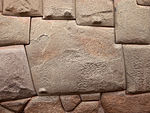
The cuel are Mapuche-built tumulus. The best known cuels are near the localities of Purén and Lumaco in Araucanía, south-central Chile. The first significant studies of the cuel were published by Tom Dillehay and José Saavedra in 2003 and 2007. The word cuel is a neologism formed from the mapudungun word kuel, meaning boundary marker (Spanish: lindero) according to the 18th century dictionary of Andrés Febrés.
References
- Dillehay, Tom. (2007). Monuments, empires and resistance. Cambridge University Press. 504 p.
- Dillehay, Tom D.; Saavedra Z., José (2003). "Interacción Humana y Ambiente: el desarrollo de Kuel en Puren-Lumanco (Region de la Araucania)" (PDF). Revista Austral de Ciencias Sociales (in Spanish) (7). Archived from the original (PDF) on 2007-07-17. Retrieved 2020-08-13.
- Febrés, Andrés (1765). Arte de la lengua general del Reyno de Chile (in Spanish). Lima. p. 463.
| Native American architecture | ||
|---|---|---|
| Styles |  | |
| Building types | ||
| Structures | ||
| Elements | ||
This article relating to archaeology in Chile is a stub. You can help Misplaced Pages by expanding it. |